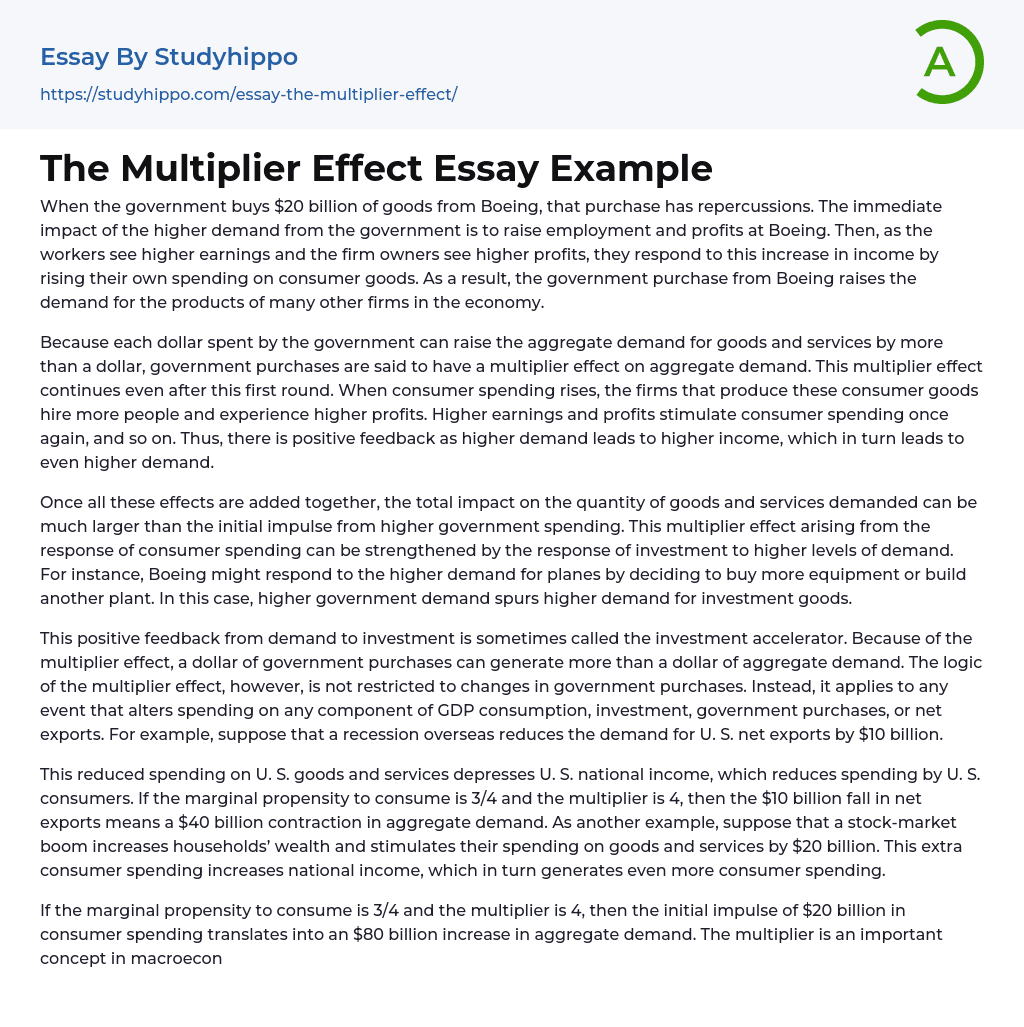When the government buys $20 billion of goods from Boeing, that purchase has repercussions. The immediate impact of the higher demand from the government is to raise employment and profits at Boeing. Then, as the workers see higher earnings and the firm owners see higher profits, they respond to this increase in income by rising their own spending on consumer goods. As a result, the government purchase from Boeing raises the demand for the products of many other firms in the economy.
Because each dollar spent by the government can raise the aggregate demand for goods and services by more than a dollar, government purchases are said to have a multiplier effect on aggregate demand. This multiplier effect continues even after this first round. When consumer spending rises, the firms that produce these consumer goods hire more peopl
...e and experience higher profits. Higher earnings and profits stimulate consumer spending once again, and so on. Thus, there is positive feedback as higher demand leads to higher income, which in turn leads to even higher demand.
Once all these effects are added together, the total impact on the quantity of goods and services demanded can be much larger than the initial impulse from higher government spending. This multiplier effect arising from the response of consumer spending can be strengthened by the response of investment to higher levels of demand. For instance, Boeing might respond to the higher demand for planes by deciding to buy more equipment or build another plant. In this case, higher government demand spurs higher demand for investment goods.
This positive feedback from demand to investment is sometimes called
the investment accelerator. Because of the multiplier effect, a dollar of government purchases can generate more than a dollar of aggregate demand. The logic of the multiplier effect, however, is not restricted to changes in government purchases. Instead, it applies to any event that alters spending on any component of GDP consumption, investment, government purchases, or net exports. For example, suppose that a recession overseas reduces the demand for U. S. net exports by $10 billion.
This reduced spending on U. S. goods and services depresses U. S. national income, which reduces spending by U. S. consumers. If the marginal propensity to consume is 3/4 and the multiplier is 4, then the $10 billion fall in net exports means a $40 billion contraction in aggregate demand. As another example, suppose that a stock-market boom increases households’ wealth and stimulates their spending on goods and services by $20 billion. This extra consumer spending increases national income, which in turn generates even more consumer spending.
If the marginal propensity to consume is 3/4 and the multiplier is 4, then the initial impulse of $20 billion in consumer spending translates into an $80 billion increase in aggregate demand. The multiplier is an important concept in macroeconomics because it shows how the economy can amplify the impact of changes in spending. A small initial change in consumption, investment, government purchases, or net exports can end up having a large effect on aggregate demand and, therefore, the economy’s production of goods and services.
- Perfect Competition essays
- Underwriting essays
- Synergy essays
- Valuation essays
- Advertising essays
- Audience Theory essays
- Competitor Analysis essays
- Consumer essays
- Marketing Management essays
- Marketing Mix essays
- Marketing Plan essays
- Marketing Research essays
- Marketing Strategy essays
- Point Of Sale essays
- Price essays
- Procurement essays
- Product essays
- Product Differentiation essays
- Promotion essays
- Promotion And Marketing Communications essays
- Retailing essays
- Trademark essays
- Anheuser-busch essays
- Brands essays
- Detergent essays
- Product Placement essays
- Research Design essays
- New Product Development essays
- Advertisement essays
- Brand essays
- Sales Promotion essays
- Advertising campaign essays
- Consumer behaviour essays
- Offer And Acceptance essays
- Wal-Mart essays
- Discover essays
- The price essays
- Culture essays
- Social Control essays
- Citizenship essays
- Social Justice essays
- Caste System essays
- Social Responsibility essays
- Socialization essays
- Deviance essays
- Modern Society essays
- Popularity essays
- Civil Society essays
- Community essays
- Female essays




